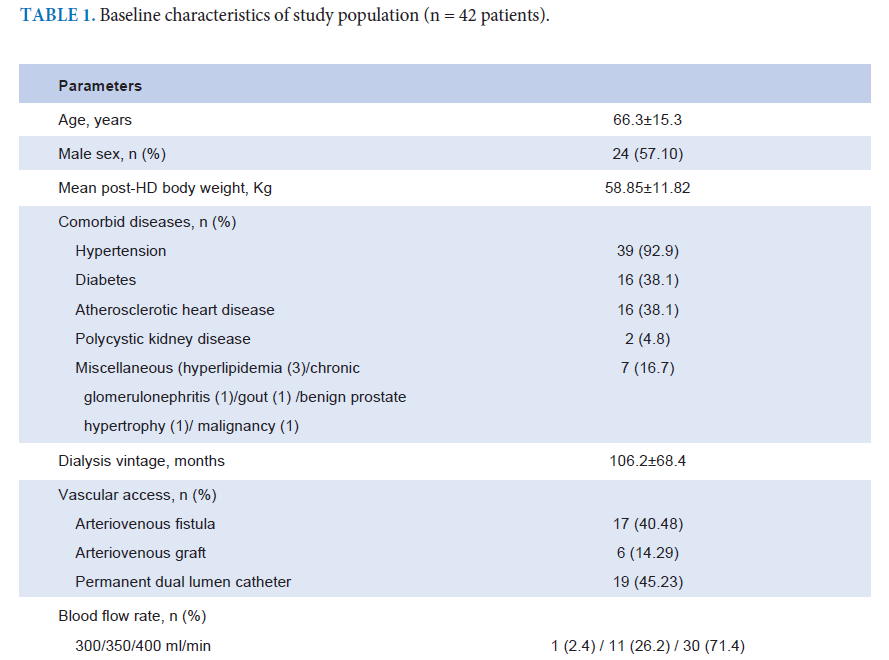Increasing Dialysate Flow Rate over 500 ml/min for Reused High-Flux Dialyzers do not Increase Delivered Dialysis Dose: A Prospective Randomized Cross Over Study
DOI:
https://doi.org/10.33192/Smj.2022.19Keywords:
Dialysate flow rate, hemodialysis adequacy, reused dialyzer, delivered Kt/V, online Kt/V, equilibrated Kt/VAbstract
Objective: The primary objectives were: 1) to study the impact of Qd (500 vs 800 ml/min) on the delivered dose by reused dialyzers, and 2) to determine dialysis efficiency of a dialyzer reused 15 times.
Materials and Methods: A prospective randomized-controlled crossover study was conducted in 42 thrice-weekly hemodialysis (HD) patients (630 HD sessions in each Qd). Delivered doses at both Qds were assessed by single-pool Kt/V (spKt/V), equilibrated Kt/V (eKt/V) and online clearance monitoring Kt/V (Kt/VOCM), measured at mid-week HD session using a new dialyzer and then again at every mid-week HD session.
Results: Although the spKt/V in HD sessions using new dialyzers at Qd of 500 ml/min was slightly lower than spKt/V at Qd of 800 ml/min (2.19±0.08 vs. 2.34±0.08, respectively, P=0.04), when accounting for urea rebound as assessed by eKt/V and Kt/VOCM, there was no significant difference. The average delivered doses in dialyzers reused 15 times, with the mean average of spKt/V, eKt/V and Kt/VOCM at Qd 500 ml/min, were not significantly inferior to the delivered doses at Qd 800 ml/min. Reusing a dialyzer 15 times did not decrease dialysis efficiency and delivered doses in all HD sessions reached spKt/V >1.4.
Conclusion: Increasing Qd over 500 ml/min for modern dialyzers does not significantly increase delivered dose of dialysis. Dialyzer reuse does not affect dialysis efficiency and provides adequate dialysis therapy.
References
John Daugirdas TAD, Jula Inrig, Rajnish Mehrotra, Michael V. Rocco, Rita Suri, Daniel E. Weiner, Jeffrey Berns. KDOQI Clinical practice guideline for hemodialysis adequacy: 2015 update. Am J Kidney Dis 2015;66(5):884-930.
Ashby D, Borman N, Burton J, Richard C, Davenport A, Farrington K, et al. Renal association clinical practice guideline on hemodialysis. BMC Nephrology 2019; 20:379. doi: 10.1186/s12882-019-1527-3.
Hootkins R. Lessons in dialysis, dialyzers, and dialysate. Dialysis & Transplantation 2011; 40: 392-396
Leypoldt JK, Cheung AK, Agodoa LY, Daugirdas JT, Greene T, Keshaviah PR. Hemodialyzer mass transfer-area coefficients for urea increase at high dialysate flow rates. The Hemodialysis (HEMO) Study. Kidney Int 1997;51(6):2013-7.
Hauk M, Kuhlmann MK, Riegel W, Köhler H. In vivo effects of dialysate flow rate on Kt/V in maintenance hemodialysis patients. Am J Kid Dis 2000;35(1):105-11.
Ouseph R, Ward RA. Increasing dialysate flow rate increases dialyzer urea mass transfer-area coefficients during clinical use. Am J Kidney Dis 2001; 37(2): 316-20.; 51(6): 2013-7
Hirano A, Kida S, Yamanoto K, Sakai K. Experimental evaluation of flow and dialysis performance of hollow-fiber dialyzers with different packing densities. J Artif Organs 2012; 15:168-75.
Ward RA, Idoux JW, Hamdan H, Ouseph R, Depner TA, Golper TA. Dialysate flow rate and delivered Kt/Vurea for dialyzers with enhanced dialysate flow distribution. Clin J Am Soc Nephrol 2011;6(9): 2235-9.
Albalate M, Pere-Garcia R, de Sequra P, Corchete E, Alcazar R, Ortega M, et al. Is it useful to increase dialysate flow rate to improve the delivered Kt? BMC Nephrology 2015; 16:20. doi:10.1186/s12882-015-0013-9.
Bhimani JP, Ouseph R, Ward RA. Effect of increasing dialysate flow rate on diffusive mass transfer of urea, phosphate and B2-microglobulin during clinical hemodialysis. Nephrol Dial Transplantation 2010;25(12):3990-5.
Daugirdas JT, Schneditz D. Overestimation of hemodialysis dose depends on dialysis efficiency by regional blood flow but not by conventional two pool urea kinetic analysis. ASAIO J 1995; 41: M719-M724.
Aslam S, Saggi SJ, Salifu M, Kossmann RJ. Online measurement of hemodialysis adequacy using effective ionic dialysance of sodium-a review of its principles, applications, benefits, and risks. Hemodialysis Int 2018; 22:425-34.
Molano-Trivino A, Meid B, Guzman G, et al. Effect of decreasing dialysis fluid flow rate on dialysis efficacy and interdialytic weight gain in chronic hemodialysis-FLUGAIN Study. Nephrol Dial Transplant 2018;33 (Suppl 1): i514-i515.
Ahrenholz P, Taborsky P, Bohling M, Rawer P, Ibrahim N, Gajdos M, et al. Determination of dialysis dose: A clinical comparison of methods. Blood Purif 2011;32: 271-7.
Cheung AK, Agodoa LY, Daugirdas JT, Depner TA, Gotch FA, Greene T, et al. Effect of hemodialyzer reuse on clearances
of urea and β2-microglobumin. J Am Soc Nephrol 1999;10:117-27.
Ouseph R, Smith BP, Ward RA. Maintaining blood compartment volumes in dialyzers reprocessed with paracetic acid maintains Kt/V but not B2-microglobulin removal. Am J Kidney Dis 1997;30: 501-6.
Tarrass F, Benjelloun M, Benjelloun O, Bensaha T. Water conservation: an emerging but vital issue in hemodialysis therapy. Blood Purif 2010;30: 181-5.
Yau A, Agar JWM, Barraclough KA. Addressing the Environmental Impact of Kidney Care. Am J Kidney Dis 2021;77: 406-409.
Denny GB, Golper TA. Does hemodialyzer reuse have a place in current ESRD care: “to be or not to be?” Semin Dial 2014;27:256-8.
Upadhyay A, Jaber BL. Reuse and Biocompatibility of Hemodialysis Membranes: Clinically Relevant? Semin Dial 2017;30: 121-4.

Published
How to Cite
Issue
Section
License

This work is licensed under a Creative Commons Attribution-NonCommercial-NoDerivatives 4.0 International License.
Authors who publish with this journal agree to the following conditions:
Copyright Transfer
In submitting a manuscript, the authors acknowledge that the work will become the copyrighted property of Siriraj Medical Journal upon publication.
License
Articles are licensed under a Creative Commons Attribution-NonCommercial-NoDerivatives 4.0 International License (CC BY-NC-ND 4.0). This license allows for the sharing of the work for non-commercial purposes with proper attribution to the authors and the journal. However, it does not permit modifications or the creation of derivative works.
Sharing and Access
Authors are encouraged to share their article on their personal or institutional websites and through other non-commercial platforms. Doing so can increase readership and citations.














